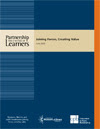 The Lessons of Collaboration: Public Libraries and Public BroadcastingLibrary Journal: July 31, 2009 by Lynn Blumenstein
The Lessons of Collaboration: Public Libraries and Public BroadcastingLibrary Journal: July 31, 2009 by Lynn Blumenstein• Partnerships more valuable in challenging economic times
• Anticipating growth in Hispanic population
• Philly addresses crime; WV looks at obesity
Twenty projects involving libraries, museums, and public television and radio broadcasters were funded between 2005 and 2006, which are profiled in a new publication, "Partnership for a Nation of Learners: Joining Forces, Creating Value."
"This publication…spotlights exemplary community partnerships across the country and shares ‘how-to’ information on successful collaborations, noted IMLS director Anne-Imelda Radice. "In these challenging economic times, partnerships are more valuable than ever."
Story continues below ↓
KCRB, the Sonoma County Library (SCL), and the Sonoma County Museum, CA, collaborated to produce Tengo La Voz ("I Have the Voice"), a multipronged effort to engage Hispanic teens and young adults, whose exploding population is dealing with teen pregnancy and gang involvement.
Iowa Public Television, the State Library of Iowa, and the Iowa Department of Education Iowa teamed up to improve reading skills among Hispanic parents so they could foster reading within their families.
The Free Library of Philadelphia (FLP) hosted multifaceted effort to combat rising crime rates. Children ages 6 to 18 were the target of a variety of programs and media efforts developed by House of UMOJA, FLP, University of Pennsylvania’s WXPN-FM, and the Atwater Kent Museum.
The Clay Center for the Arts and Sciences, West Virginia Public Broadcasting, and the Kanawha County Public Library (KCPL), Charleston, WV, worked together to address childhood obesity.
The main challenge was the cost of the program, but the IMLS grant gave the project credibility and helped the partners win additional funding. READ MORE (with links) !
Partnerships:
Beginning a Healthy Life—Charleston, WV
KC Science, INC—Kansas City, MO
Kids with Asthma Can!—Boston, MA
Saving Nebraska’s Treasures—Lincoln, NE
The Voices Project—Haines, AK
Water Wise Utah—Salt Lake City, UT
Alamo Youth Radio Project—Alamo, NM
Cambridge Science Festival and Science City—Cambridge, MA
Currier & Ives: Perspectives on America—Springfield, MA
Eye on the Night Sky—Saint Johnsbury, VT
Family Literacy for New Iowans—Johnston, IA
Forward Together—Columbia, SC
From Resistance to Rights—Lansing, MI
Greater New Haven Family Learning Partnership—New Haven, CT
Lake Champlain Voyages of Discovery—Montpelier, VT
Open Doors—Las Vegas, NV
Philadelphia Partnership for Peace—Philadelphia, PA
Maine Homefront Veterans Project—Portland, ME
Tengo La Voz (“I Have The Voice”)—Rohnert Park, CA
Witness to a Century—Richmond, VA









